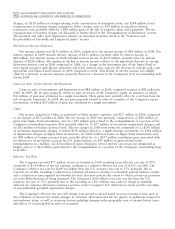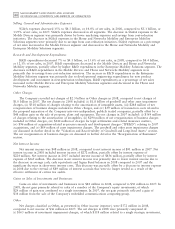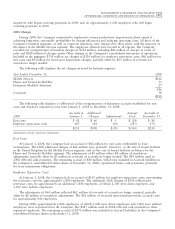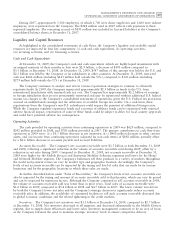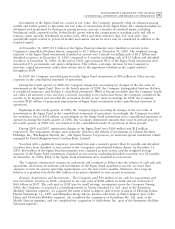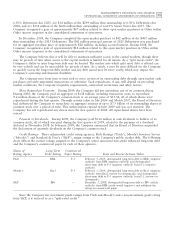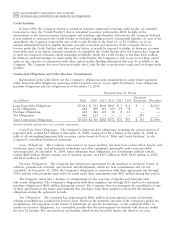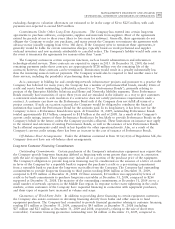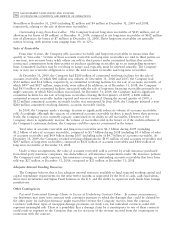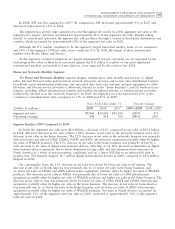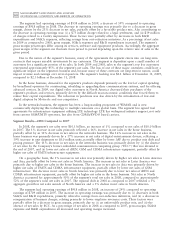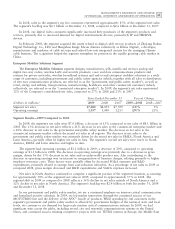Motorola 2009 Annual Report Download - page 59
Download and view the complete annual report
Please find page 59 of the 2009 Motorola annual report below. You can navigate through the pages in the report by either clicking on the pages listed below, or by using the keyword search tool below to find specific information within the annual report.
51
MANAGEMENT’S DISCUSSION AND ANALYSIS
OF FINANCIAL CONDITION AND RESULTS OF OPERATIONS
Investments in the Sigma Fund are carried at fair value. The Company primarily relies on valuation pricing
models and broker quotes to determine the fair value of investments in the Sigma Fund. The valuation models are
developed and maintained by third-party pricing services, and use a number of standard inputs, including
benchmark yields, reported trades, broker/dealer quotes where the counterparty is standing ready and able to
transact, issuer spreads, benchmark securities, bids, offers and other reference data. For each asset class,
quantifiable inputs related to perceived market movements and sector news may be considered in addition to the
standard inputs.
At December 31, 2009, $5.1 billion of the Sigma Fund investments were classified as current in the
Company’s consolidated balance sheets, compared to $3.7 billion at December 31, 2008. The weighted average
maturity of the Sigma Fund investments classified as current was 1 month (excluding cash of $0.2 billion and
defaulted securities) at December 31, 2009, compared to 5 months (excluding cash of $1.1 billion and defaulted
securities) at December 31, 2008. At the end of 2009, approximately 90% of the Sigma Fund investments were
invested in U.S. government and agency obligations. This reflects a strategic decision by the Company to
prioritize capital preservation rather than returns due to the significant volatility in the capital markets
throughout 2009.
In 2009, the Company recorded gains from the Sigma Fund investments of $80 million in Other income
(expense) in the consolidated statement of operations.
During the fourth quarter of 2008, the Company changed its accounting for changes in the fair value of
investments in the Sigma Fund. Prior to the fourth quarter of 2008, the Company distinguished between declines
it considered temporary and declines it considered permanent. When it became probable that the Company would
not collect all amounts it was owed on a security according to its contractual terms, the Company considered the
security to be impaired and recorded the permanent decline in fair value in earnings. In 2008, the Company
recorded $186 million of permanent impairments of Sigma Fund investments in the consolidated statement of
operations.
Beginning in the fourth quarter of 2008, the Company began recording all changes in the fair value of
investments in the Sigma Fund in the consolidated statements of operations. Accordingly, the Company recorded
the cumulative loss of $101 million on investments in the Sigma Fund investments in its consolidated statement of
operations during the fourth quarter of 2008. The Company determined amounts that arose in periods prior to
the fourth quarter of 2008 were not material to the consolidated results of operations in those periods.
During 2008 and 2007, impairment charges in the Sigma Fund were $186 million and $18 million,
respectively. The impairment charges were primarily related to the default of investments in Lehman Brothers
Holdings, Inc., Washington Mutual, Inc., and Sigma Finance Corporation, an unrelated special investment vehicle
managed by United Kingdom-based Gordian Knot, Limited.
Securities with a significant temporary unrealized loss and a maturity greater than 12 months and defaulted
securities have been classified as non-current in the Company’s consolidated balance sheets. At December 31,
2009, $66 million of the Sigma Fund investments were classified as non-current, and the weighted average
maturity of the Sigma Fund investments classified as non-current (excluding defaulted securities) was 24 months.
At December 31, 2008, $466 of the Sigma Fund investments were classified as non-current.
The Company continuously assesses its cash needs and continues to believe that the balance of cash and cash
equivalents, short-term investments and investments in the Sigma Fund classified as current are more than
adequate to meet its current operating requirements over the next twelve months. Therefore, the Company
believes it is prudent to hold the $66 million of securities classified as non-current to maturity.
Strategic Acquisitions and Investments: The Company used $50 million of net cash for acquisitions and
new investment activities in 2009, compared to net cash used of $282 million in 2008 and net cash used of
$4.6 billion in 2007. The cash used in 2009 was for small strategic investments across the Company. During
2008, the Company: (i) acquired a controlling interest in Vertex Standard Co. Ltd. (part of the Enterprise
Mobility Solutions segment), (ii) acquired the assets related to digital cable set-top products of Zhejiang Dahua
Digital Technology Co., LTD. and Hangzhou Image Silicon, known collectively as Dahua Digital (part of the
Home and Networks Mobility segment), (iii) completed the acquisition of Soundbuzz Pte. Ltd. (part of the
Mobile Devices segment), and (iv) completed the acquisition of AirDefense, Inc. (part of the Enterprise Mobility
Solutions segment).



